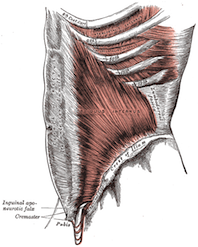Fascia
Original Editor - Laura Ritchie
Top Contributors - Esraa Mohamed Abdullzaher, Laura Ritchie, Sehriban Ozmen, Lucinda hampton, Andeela Hafeez, Stacy Schiurring, Admin, WikiSysop, Evan Thomas, Kim Jackson, Carin Hunter and Carina Therese Magtibay
Introduction[edit | edit source]
A fascia is a layer of fibrous tissue. A fascia is a structure of connective tissue that surrounds muscles, groups of muscles, blood vessels, and nerves, binding some structures together, while permitting others to slide smoothly over each other. Various kinds of fascia may be distinguished. [1]
Like ligaments, aponeuroses, and tendons, fasciae are dense regular connective tissues, containing closely packed bundles of collagen fibers oriented in a wavy pattern parallel to the direction of pull. Fasciae are consequently flexible structures able to resist great unidirectional tension forces until the wavy pattern of fibers has been straightened out by the pulling force. These collagen fibers are produced by the fibroblasts located within the fascia. [1]
Fasciae are similar to ligaments and tendons as they are all made of collagen except that ligaments join one bone to another bone, tendons join muscle to bone and fasciae surround muscles or other structures. [1]
Structure[edit | edit source]
There exists some controversy about what structures are considered "fascia", and how fascia should be classified.[2] The two most common systems are:[2]
The one specified in the 1983 edition of Nomina Anatomica (NA 1983)
The one specified in the 1997 edition of Terminologia Anatomica (TA 1997)
| NA 1983 | TA 1997 | Description | Example |
| Superficial fascia | (not considered fascia in this system) |
This is found in the subcutis in most regions of the body, blending with the reticular layer of the dermis. | Fascia of Scarpa |
| Deep fascia | Fascia of muscles | This is the dense fibrous connective tissue that interpenetrates and surrounds the muscles, bones, nerves and blood vessels of the body. | Transversalis fascia |
| Visceral fascia | Visceral fascia, parietal fascia | This suspends the organs within their cavities and wraps them in layers of connective tissue membranes. | Pericardium |
Force transmission and elastic properties of fascia [edit | edit source]
Fascia like other soft tissues has variable degree of elasticity that allow it to withstand deformation when forces and pressure are applied as it can recover and return to its starting shape and size .It respond to load , compression and force as at the begining of loading fascia fascia has an elastic response in which a degree of slack is taken up .Over time, if loading persists in a slow and sustained manner, creep develops, which is a slow, delayed yet continuous deformation. After that , an actual volume change occurs as water is forced from the tissue .When loading ceases fascia return to its original shape .The restoration of shape occurs through elastic recoil via hysteresis, (which is the process of energy use and loss in which tissues are loaded and unloaded) .The time needed for tissue to return to normal via elastic recoil depends on the uptake of water by the tissue and whether its elastic potential has been exceeded.
When loaded for any length of time, tissues lengthen and distort until they reach a point of balance. If loading is sustained, over time, chronic deformation will result. [3]
Conditions that affect Fascia[edit | edit source]
Fascia shorten, solidifies and thicken in response to:
- trauma
- anything physically or emotionally injurious to the body
- inflammation
- poor posture
- or anything that cause the body to lose its physiological adaptive capacity
This called a binding down of fascia .[4]
Management / Interventions[edit | edit source]
Resources[edit | edit source]
The following videos provide additional information regarding fascia and can be viewed on the YouTube channel "Integral Anatomy."
- Integral Anatomy, V1 pt1: Skin & Superficial Fascia
- Integral Anatomy V1 pt2: Skin and Superficial Fascia
- Integral Anatomy V2 pt1: Deep Fascia and Muscle
- Integral Anatomy, V2 pt2: Deep Fascia and Muscle
- Integral Anatomy V3 pt1: Cranial and Visceral Fasciae
- Integral Anatomy V3 pt2: Cranial and Visceral Fasciae
- Integral Anatomy V4 pt1: Viscera and their Fasciae
- Integral Anatomy V4 pt 2: Viscera and their Fasciae
Recent Related Research (from Pubmed)[edit | edit source]
References[edit | edit source]
- ↑ 1.0 1.1 1.2 Fascia. Wikipedia, the free encyclopedia. http://en.wikipedia.org/wiki/Fascia (last accessed 13 Oct 2013).
- ↑ http://en.wikipedia.org/wiki/Fascia
- ↑ Ruth Duncan . Myofascial release (hands-on guide for therapists ) . 1st ed , 2014 .
- ↑ Ruth Duncan . Myofascial release (hands-on guide for therapists) . 1st ed, 2014.







